Mad Hedge Technology Letter
March 25, 2022
Fiat Lux
Featured Trade:
(THE DUMPSTER FIRE SUB-SECTOR OF TECH)
(SSYS), (DDD), (PRLB)

Mad Hedge Technology Letter
March 25, 2022
Fiat Lux
Featured Trade:
(THE DUMPSTER FIRE SUB-SECTOR OF TECH)
(SSYS), (DDD), (PRLB)

Avoid 3D printing stocks.
It’s not because I hate these companies, but when I delve beneath the surface of these business models, they just aren’t good enough.
3D printing is a great phenomenon, but so was the digital handheld pet Tamagotchi invented by Japanese company Bandai in 1996.
Tamagotchis only went so far, and so will 3D printing.
Take for instance, in just a decade, 3D-printed guns have come a long way from a fully functional 3D-printable semiautomatic pistol carbine entirely printed at home to what now appears to be a rocket launcher-like device.
Does that mean that the U.S. military will start manufacturing Blackhawk helicopters and industrial-grade surface-to-air missile weapons on a 3D printer?
Hell no.
The fact is that for the crème of the crop products, the ones that bring in the revenue that make your eyes big, manufacturers aren’t going to choose a 3D printer to make these products.
If 3D printing isn’t used for these premium products, it means that building an accelerated revenue model will be almost impossible.
Take for instance automobiles, they aren’t a subscription-based business, but car companies scale globally and to all parts of the globe.
I can’t think of one country that doesn’t need cars as a main input in their domestic economy apart from possibly Papa New Guinea.
A classic car dealership might have a 3D printer to replace a few cosmetic parts and if the parts squeak, it's either that part or nothing as there are no more spare parts.
For high quality German cars, drivers would need to wait for the specific part from the specific supplier.
Car manufacturers have high standards, car parts have specific requirements concerning strength, fatigue, heat, fire, color, finish level, recycling, the classic parts are rather cheap to make for cars that sell in high volume, car parts are in general not designed to make with a 3D printer.
Good luck if you’re waiting around for an entire car to be printed, because it will probably never happen.
Most parts in cars need to be strong, lightweight, heat resistant, have a fine finish.
They are often quite big it would be unfeasible to have a 3D printer the size of a 500 sq foot room.
3D printers that size also scale poorly.
With all this being said, let’s take a peak at the financials.
One of the top 3D printing companies Stratasys Ltd. (SSYS) achieved $663 million of annual revenue in 2018 and fast forward to 2021, they decelerated to $607 million.
Not only is revenue decelerating, but they don’t turn a profit.
SSYS lost $62 million in 2021 and they have lost money for the past 4 years.
Let’s find another example in 3D Systems Corporation (DDD) headquartered in Rock Hill, South Carolina.
In 2018, they achieved $691 million of annual revenue and continued to decelerate and earn $615 million in revenue in 2021.
Essentially, some of the largest 3D printing stocks have topped out at a sub-$700 million per year clip and are going in the opposite direction.
Loss-making and revenue deceleration are the two characteristics that investors hate most.
One of the only 3D printing companies to grow revenue in the past 4 years was Proto Labs, Inc. (PRLB).
In 2018, PRLB achieved annual revenue of $445 million and surged ahead to make $488 million in revenue in 2021.
These growth numbers are paltry relative to any other tech sub-sector.
In short, these companies have little access to big revenue-making opportunities, and lucrative industries don’t view them as high quality enough to mass produce anything of real value.
Decelerating revenue, decelerating EPS, and unprofitability are all deal breakers.
Avoid 3D printing stocks like the plague.
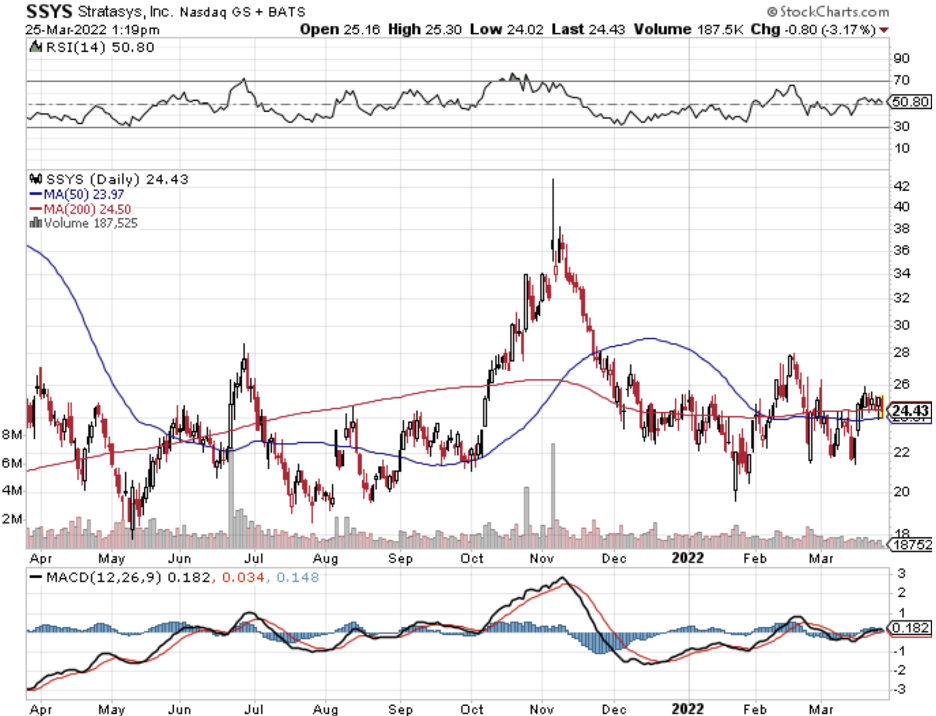
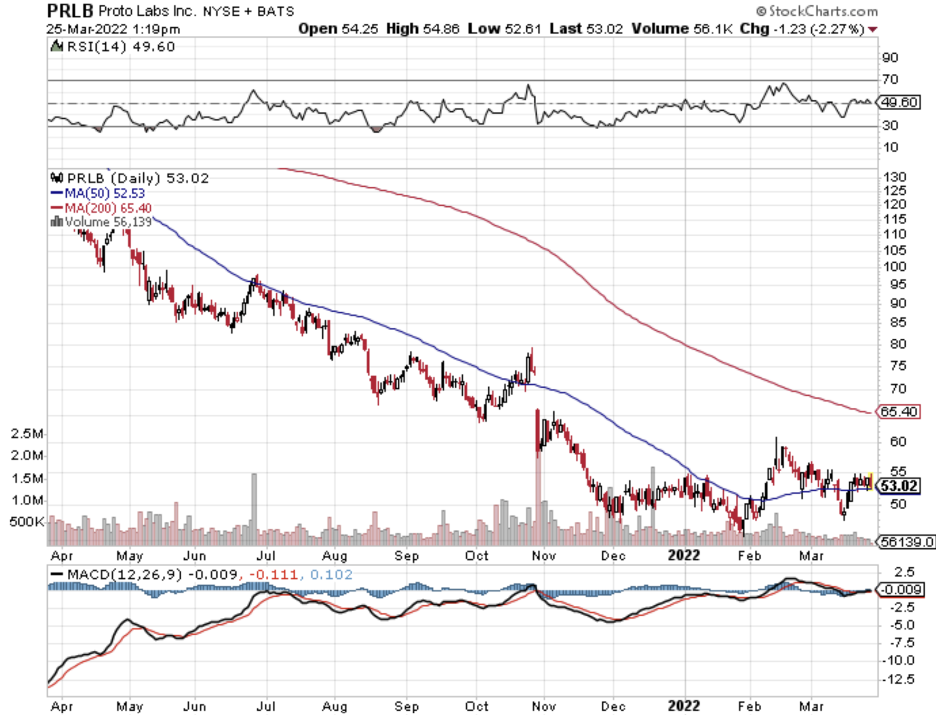
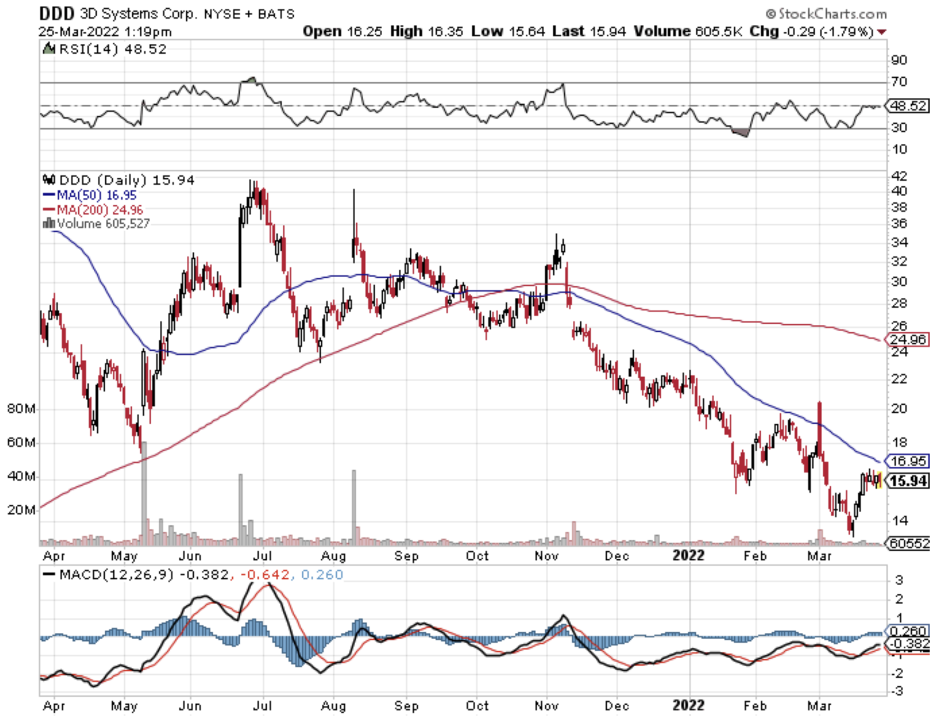
Mad Hedge Technology Letter
January 22, 2021
Fiat Lux
Featured Trade:
(THE ADDITIVE MANUFACTURING BOOM)
(DM), (DDD), (SSYS), (GE)

Desktop Metal (DM) produces metal and carbon fiber 3D printing accessible to all engineers, designers, and manufacturers.
I’ve dipped my toe in this industry before by recommending Stratasys Ltd. (SSYS) whose stock has tripled from October 2020.
Since its inception, the company has been a happy recipient of generous funding channels and attracted total funding of $438M, always a good start.
Desktop Metal is truly well-capitalized after its SPAC transaction and strategically positioned to reap the rewards from a "dramatic increase" in the use of 3D printing for end-use part production over the next decade.
The company's outsourcing of manufacturing processes should generate strong free cash flow which should turn positive by 2023.
Sales are expected to explode 286% this year alone, passing $71 million by the end of 2021 as this technology becomes more mainstream.
This is the only publicly traded, pure-play additive manufacturing 2.0 company, and DM has the fastest metal 3D printing technology in the market.
DM is 20 times cheaper than existing laser-based metal 3D printing technologies while allowing the use of a much wider range of alloys.
Not only are they expanding at a rapid clip, but they are also in the perfect market to grow with revenue runway of 11x to $146B this decade, propelled by a shift from prototyping to mass production.
Unlike many other tech startups, the first-mover advantage is buttressed by a diverse blue-chip customer base in the automotive industry.
The automotive industry is a key vertical for volume additive manufacturing and they have started shipping a new, intermediate version of its P-50 Production System, the new P-1 printer, to Ford Motor Company (F).
Buying growth has been a go-to strategy for frothy tech companies as deploying extra capital to take advantage of new efficiencies by owning new assets has been a winning strategy.
M&A is a solid route as a “value creation” strategy and the systems subsector would appear to present a viable strategic acquisition candidate going forward.
Desktop Metal recently bought competitor 3D printing firm EnvisionTEC.
Founded in Germany in 2002, EnvisionTEC specializes in photopolymer additive manufacturing, putting its technology in more direct competition with the likes of 3D printing darling Carbon than Desktop Metal’s own existing competencies.
It’s pouring $300 million to acquire EnvisionTEC through a combination of cash and stock.
There is a great chance for Desktop Metal to grow here.
EnvisionTEC has the underlying technology with the ability to print in more than 190 materials, and Desktop Metal has the resources to help scale that tech.
Today, EnvisionTEC has over 5,000 customers across a broad spectrum of industries, including medical devices, jewelry, automotive, aerospace, and biofabrication.
They are major players in the dental market, more than tripling the number of Envision One dental shipments from 2019 to 2020 and with over 1,000 dental customers now using its AM machines for end-use parts.
Key customers include Cartier, Celgene, Ford, Hasbro, Oral Arts, Stuller, and Smile Direct Club.
In addition to extensive customer adoption, EnvisionTEC has a broad library of over 190 materials, featuring photopolymer resins with material properties in-line with or exceeding those of thermoplastics and multiple FDA-listed and 510(K)-cleared resins for the manufacturing of medical devices.
The company augments its robust proprietary material development efforts with a selectively open business model, leveraging relationships with major chemical companies such as Henkel Loctite, DSM Somos, Detax, Keystone, and Arkema to sell third-party, industry-validated resins for use with its additive manufacturing platforms.
This is most likely the beginning of many purchases as they are flush with new capital from the IPO and other outside investors.
Investors need to know there are a few risks to take note of.
The rapid prototyping to mass production timetable appears quite ambitious, especially since DM has had significant issues with deploying its technology in the field.
Also, the attractive branding of “additive manufacturing 2.0” perhaps could turn into an overhyped industry.
Even though they have solid technology to become successful, there are industry veterans that won’t just lie down including 3D Systems Corporation (DDD), General Electric (GE), (GE Additives), and SSYS.
These recipients are also beneficiaries of all the hot money pouring into the sector the past year.
China could also bring down the 3D printing sector with a race to zero type of domino effect.
DM is a 3D printing company stock to put on their watchlist and buying growth isn’t always a guarantee to buy the “right” growth, but let’s see how they execute it.
Either case, the secular tailwinds can’t be ignored and if this technology goes viral, then watch out.
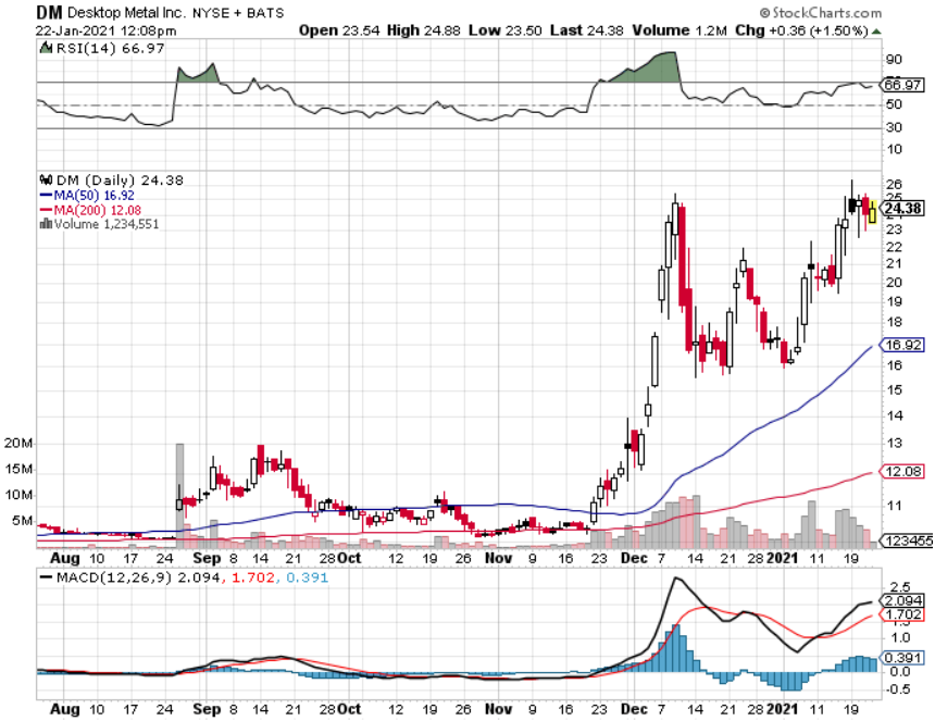

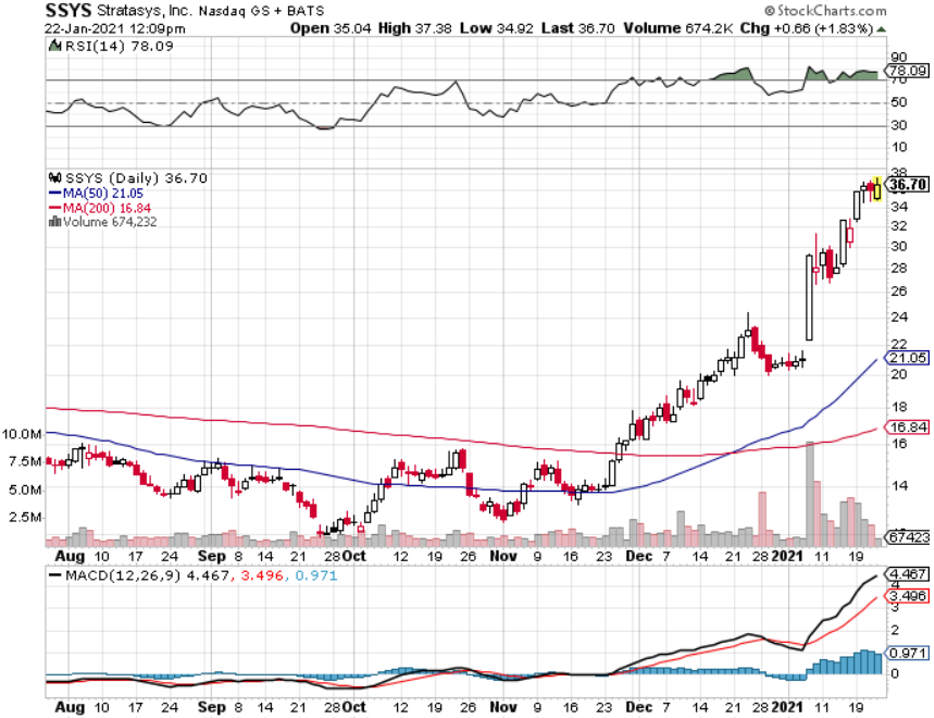
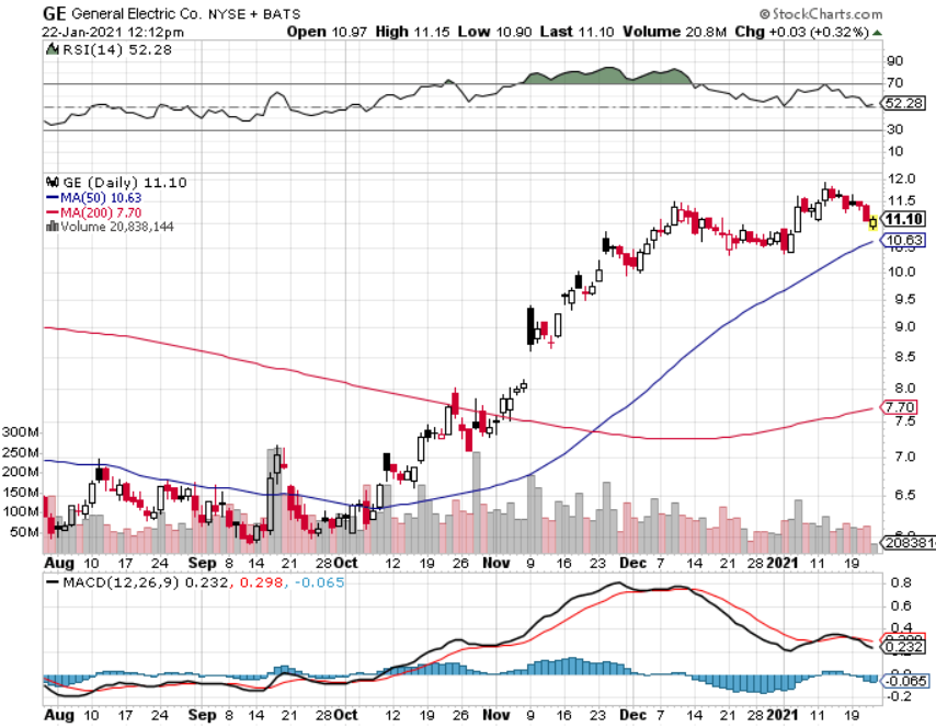
Mad Hedge Technology Letter
October 16, 2019
Fiat Lux
Featured Trade:
(IS 3D PRINTING A WASTE OF SPACE?)
(SSYS), (ETSY), (MSFT), (BA), (NFLX), (GE), (LMT)

If you need a new investment theme – here’s one.
3D printing.
Yes, the same 3D printing that was once considered a raging but hopeless fad.
A lot has changed since then.
Early adopters were largely cut down at the knees as they tried to traverse the rocky terrain from a niche market to going full out mainstream.
Production complications and the lack of specialists in the industry meant that problems were rampant and nurturing an industry from scratch is harder than you think.
Believe me, I’ve been there and done that.
It is time to stand up and take notice of 3D printing, this time it is here to stay.
Certain tech companies love this technology like e-commerce company Etsy (ETSY) who focuses on personalized handcrafts.
The cost of production doesn’t change whether you’re producing one item or a million because of the economies of scale.
The previous 3D printing bonanza was a frenzy and this corner of tech became known for the use of buzzwords representing the potential to reinvent the world.
With lofty expectations, there was a natural disappointment when outsiders understood growing pains were part of the critical evolution instead of a direct route to profits.
The initial goal was to democratize production which sounds eerily similar to bitcoins mantra of democratizing money.
The way to do this was to make it simple to produce whatever one wishes.
That would assume that the general public could pick up professional production 3D printing skills on arrival.
That was wishful thinking.
The truth was that applying 3D printers was tedious.
Issues cropped up like faulty first-generation hardware or software -problems that overwhelmed newbies.
Then if everything was going smoothly on that front, there was the larger issue of realizing it’s just a lot harder to design specific things than initially thought without a deep working knowledge of computer-aided software (CAD) design.
Most people know how to throw a football, but that doesn’t mean that most people can be Super Bowl quarterback Tom Brady.
The high-quality 3D printing designs were reserved for authentic professionals that could put together complicated designs.
The move to compiling a comprehensive library will help spur on the 3D printing revolution while upping the foundational skill base.
Then there is the fact that 3D printing technology is heaps better now than it once was, and the printing technology has come down in price making it more affordable for the masses.
These trends will propel broad-based adoption and as the printing process standardizes, more products can rely on this technology from scratch.
The holy grail of 3D printing would be 3D printing on demand, but imagine this on-demand 3D printing would function to personalize a physical product on the spot.
Think of a hungry customer walking into a restaurant and not even looking at a menu because one sentence would be enough to trigger specific models in the database that could conjure up the design for the meal.
This would involve integrating artificial intelligence into 3D printing and the production process would quicken to minutes, even seconds.
At some point, crafting the perfect meal or designing a personalized Tuscan villa could take minutes.
The 3D printing industry is reaching an inflection point where the advancement of the technology, expertise, and an updated production process are percolating together at the perfect time.
The company at the forefront of this phenomenon is Stratasys (SSYS).
Stratasys produces in-office prototypes and direct digital manufacturing systems for automotive, aerospace, industrial, recreational, electronic, medical and consumer products.
And when I talk about real pros who have the intellectual property to whip out a complex CAD-based 3D design, I am specifically talking about Stratasys who have been in this business since the industry was in its infancy.
And if you add in the integration of cloud software, 3D printing would dovetail nicely with it.
All the elements are in perfect in place to fuel this industry into the mainstream.
Take for example airplanes made by Boeing (BA) and Airbus - 3D printer-designed parts comprise only 0.1% of the actual plane now.
It is estimated that 3D printed design parts could potentially consist up to 25% of the overall plane.
These massive airline manufacturers like Boeing (BA) have profit margins of around 15% to 20%, and carving out more 3D printer-designed parts to integrate into the main design will boost profit margins close to 60%.
The development of the 3D printing process into aerospace technology is happening fast with Boeing inking a multi-year collaboration agreement with Swiss technology and engineering group Oerlikon to develop standard processes and materials for metal 3D printing.
Any combat pilot knows who Oerlikon is because they are famed for building ultra-highspeed machines to shoot down, you guessed it, airplanes and missiles.
They will collaborate to use the data resulting from their agreement to support the creation of a standard titanium 3D printing processes.
GE’s Aviation’s GEnx-2B aircraft engine for the Boeing 747-8 is applying a 3D printed bracket approved by the Federal Aviation Administration (FAA) for the engine, replacing a traditionally manufactured power door opening system (PDOS) bracket.
With the positive revelations that the (FAA) is supporting the adoption of 3D printing-based designs, GE has already started mass production of the 3D printed brackets at its Auburn, Alabama facility.
Defense companies are also dipping their toe into the water with aerospace company Lockheed Martin (LMT), the world’s largest defense contractor, winning a $5.8 million contract with the Office of Naval Research to help further develop 3D printing for the aerospace industry.
They will partner up to investigate the use of artificial intelligence in training robots to independently oversee the 3D printing of complex aerospace components.
3D printed designs have the potential to crash the cost of making big-ticket items from cars to nuclear plants while substantially shortening the manufacturing process.
As it stands, Stratasys is the industry leader in this field and if you believe in this long term then this stock would be for you.
It’s nonetheless still a speculative punt but a compelling pocket of the tech industry.

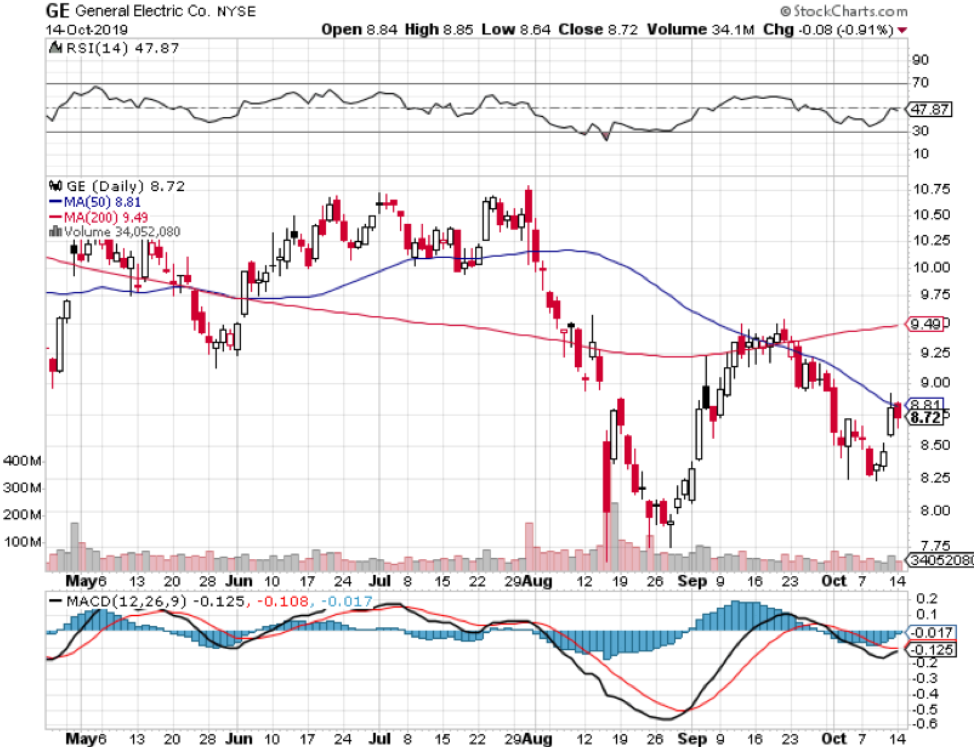
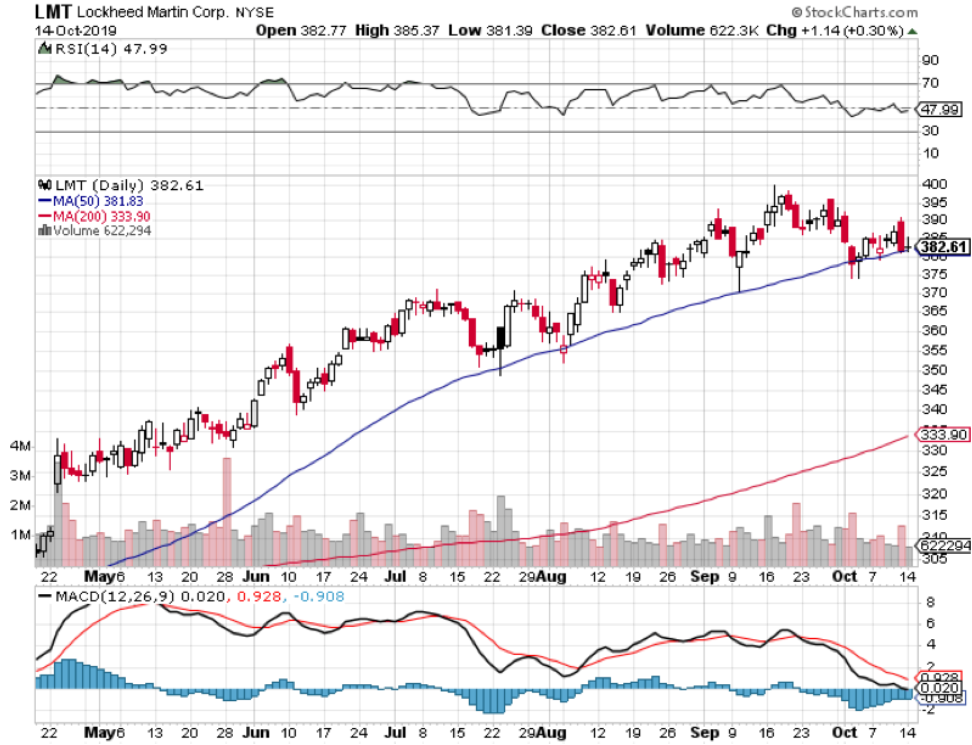
Mad Hedge Technology Letter
July 26, 2019
Fiat Lux
Featured Trade:
(WHY 3D PRINTING WILL BOOST THE AIRPLANE INDUSTRY),
(SSYS), (ETSY), (MSFT), (BA), (NFLX), (GE), (LMT)

If you need a new investment idea – here’s one.
3D printing.
Yes, the same 3D printing that was once considered a raging but hopeless fad.
A lot has changed since then.
Early adopters were largely cut down at the knees as they tried to traverse the rocky terrain from a niche market to going full out mainstream.
The teething pains echo bitcoin which was the fad of 2017, on the contrary, this technology it is built on is rock solid, yet the path to sustainability is littered with corpses.
Production complications and the lack of specialists in the industry meant that problems were rampant and nurturing an industry from scratch is harder than you think.
It is time to stand up and take notice of 3D printing, this time it is here to stay.
Certain tech companies love this technology.
Etsy (ETSY) e-commerce participants gravitate towards 3D printing because it gets firms from paper to the real world in a fraction of the time.
The cost of production doesn’t change whether you’re producing one item or a million because of the economies of scale.
The previous 3D printing bonanza was a frenzy and this corner of tech became known for the use of buzzwords representing the potential to reinvent the world.
With lofty expectations, there was a natural disappointment when outsiders understood growing pains were part of the critical evolution instead of a direct route to profits.
The initial goal was to democratize production which sounds eerily similar to bitcoins mantra of democratizing money.
The way to do this was to make it simple to produce whatever one wishes.
That would assume that the general public could pick up professional production 3D printing skills on arrival.
That was wishful thinking.
The truth was that applying 3D printers was time-draining and aggravating.
Issues cropped up like faulty first-generation hardware or software -problems that overwhelmed newbies.
Then if everything was going smoothly on that front, there was the larger issue of realizing it’s just a lot harder to design specific things than initially thought without a deep working knowledge of computer-aided software (CAD) design.
Most people know how to throw a football, but that doesn’t mean that most people can wake up one day in their pajamas and convince themselves they will be the next starting quarterback to lead an NFL team to the Super Bowl.
The high-quality 3D printing designs were reserved for authentic professionals that could put together complicated designs.
The move to compiling a comprehensive library will help spur on the 3D printing revolution while upping the foundational skill base.
Then there is the fact that 3D printing technology is a lot better now than it once was, and the printing technology has come down in price making it more affordable for the masses.
These trends will propel broad-based adoption and as the printing process standardizes, more products can rely on this technology from scratch.
The holy grail of 3D printing would be 3D printing on demand like Netflix (NFLX), but imagine this on-demand 3D printing would function to personalize a physical product on the spot.
Think of a hungry customer walking into a restaurant and not even looking at a menu because one sentence would be enough to trigger specific models in the database that could conjure up the design for the meal.
This would involve integrating artificial intelligence into 3D printing and the production process would quicken to minutes, even seconds.
At some point, crafting the perfect meal or designing a personalized Tuscan villa could take minutes.
The 3D printing industry is reaching an inflection point where the advancement of the technology, expertise, and an updated production process are brewing together at the perfect time.
The company at the forefront of this phenomenon is Stratasys (SSYS).
Stratasys produces in-office prototypes and direct digital manufacturing systems for automotive, aerospace, industrial, recreational, electronic, medical and consumer products.
And when I talk about real pros who have the intellectual property to whip out a complex CAD-based 3D design, I am specifically talking about Stratasys who have been in this business since the industry was in infancy.
And if you add in the integration of cloud software, 3D printing would dovetail nicely with it.
All the elements are in place to fuel this industry into the mainstream.
Take for example airplanes made by Boeing (BA) and Airbus, 3D printer-designed parts comprise only 0.1% of the actual plane now.
It is estimated that 3D printed design parts could consist up to 20% of the overall plane.
These massive airline manufacturers like Boeing (BA) have profit margins of around 15% to 20%, and carving out more 3D printer-designed parts to integrate into the main design will boost profit margins to up to 50%.
The development of the 3D printing process into aerospace technology is happening fast with Boeing inking a five-year collaboration agreement with Swiss technology and engineering group Oerlikon to develop standard processes and materials for metal 3D printing.
Any combat pilot knows who Oerlikon is because they are famed for building ultra-highspeed machines to shoot down, you guessed it, airplanes and missiles.
They will collaborate to use the data resulting from their agreement to support the creation of a standard titanium 3D printing processes.
Only last November, GE announced that GE’s Aviation’s GEnx-2B aircraft engine for the Boeing 747-8 will apply a 3D printed bracket approved by the Federal Aviation Administration (FAA) for the engine, replacing a traditionally manufactured power door opening system (PDOS) bracket.
With the positive revelations that the (FAA) is supporting the adoption of 3D printing-based designs, GE is preparing to begin imminent mass production of the 3D printed brackets at its Auburn, Alabama facility.
Eric Gatlin, general manager of GE Aviation’s additive integrated product team gushed that “It’s the first project we took from design to production in less than ten months.”
Defense companies are also dipping their toe into the water with aerospace company Lockheed Martin (LMT), the world’s largest defense contractor, winning a $5.8 million contract with the Office of Naval Research to help further develop 3D printing for the aerospace industry.
They will partner up to investigate the use of artificial intelligence in training robots to independently oversee the 3D printing of complex aerospace components.
3D printed designs have the potential to crash the cost of making big-ticket items from cars to nuclear plants while substantially shortening the manufacturing process.
Further emphasis on cornering the North America aerospace market could cement this stock as a no-brainer buy of 2019 as the (FAA) embraces more of the technology opening up the addressable market for the active participants.
As it stands, Stratasys is the industry leader in this field, and placing best of breed tech companies into your portfolio will put you in better position to weather the squalls of the capricious tech sector.
The company is still relatively unknown even though it has been around for ages.
Stratasys is a company to put on your radar and remember this space as the 3D printing market blossoms.
It’s nonetheless still a speculative punt but a compelling part of the tech industry.
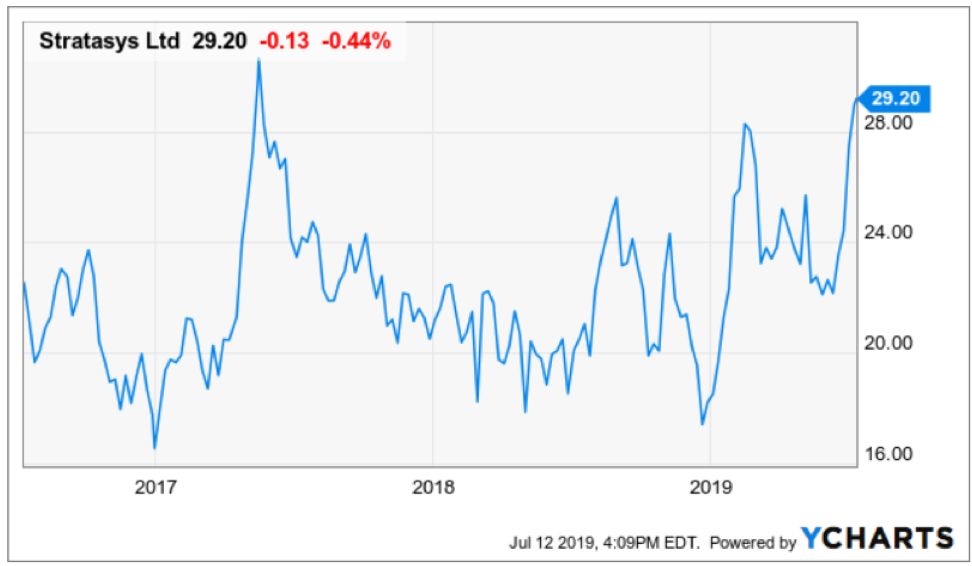
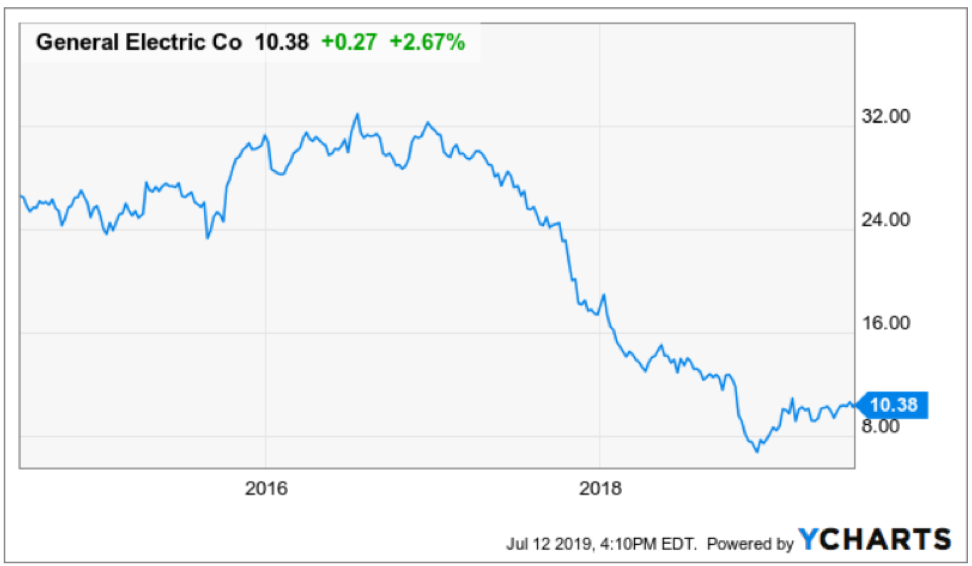

Mad Hedge Technology Letter
January 16, 2019
Fiat Lux
Featured Trade:
(3D PRINTING GETS A SECOND WIND),
(SSYS), (ETSY), (MSFT), (BA), (NFLX), (GE), (LMT)

Legal Disclaimer
There is a very high degree of risk involved in trading. Past results are not indicative of future returns. MadHedgeFundTrader.com and all individuals affiliated with this site assume no responsibilities for your trading and investment results. The indicators, strategies, columns, articles and all other features are for educational purposes only and should not be construed as investment advice. Information for futures trading observations are obtained from sources believed to be reliable, but we do not warrant its completeness or accuracy, or warrant any results from the use of the information. Your use of the trading observations is entirely at your own risk and it is your sole responsibility to evaluate the accuracy, completeness and usefulness of the information. You must assess the risk of any trade with your broker and make your own independent decisions regarding any securities mentioned herein. Affiliates of MadHedgeFundTrader.com may have a position or effect transactions in the securities described herein (or options thereon) and/or otherwise employ trading strategies that may be consistent or inconsistent with the provided strategies.
This site uses cookies. By continuing to browse the site, you are agreeing to our use of cookies.
OKLearn moreWe may request cookies to be set on your device. We use cookies to let us know when you visit our websites, how you interact with us, to enrich your user experience, and to customize your relationship with our website.
Click on the different category headings to find out more. You can also change some of your preferences. Note that blocking some types of cookies may impact your experience on our websites and the services we are able to offer.
These cookies are strictly necessary to provide you with services available through our website and to use some of its features.
Because these cookies are strictly necessary to deliver the website, refuseing them will have impact how our site functions. You always can block or delete cookies by changing your browser settings and force blocking all cookies on this website. But this will always prompt you to accept/refuse cookies when revisiting our site.
We fully respect if you want to refuse cookies but to avoid asking you again and again kindly allow us to store a cookie for that. You are free to opt out any time or opt in for other cookies to get a better experience. If you refuse cookies we will remove all set cookies in our domain.
We provide you with a list of stored cookies on your computer in our domain so you can check what we stored. Due to security reasons we are not able to show or modify cookies from other domains. You can check these in your browser security settings.
These cookies collect information that is used either in aggregate form to help us understand how our website is being used or how effective our marketing campaigns are, or to help us customize our website and application for you in order to enhance your experience.
If you do not want that we track your visist to our site you can disable tracking in your browser here:
We also use different external services like Google Webfonts, Google Maps, and external Video providers. Since these providers may collect personal data like your IP address we allow you to block them here. Please be aware that this might heavily reduce the functionality and appearance of our site. Changes will take effect once you reload the page.
Google Webfont Settings:
Google Map Settings:
Vimeo and Youtube video embeds:
